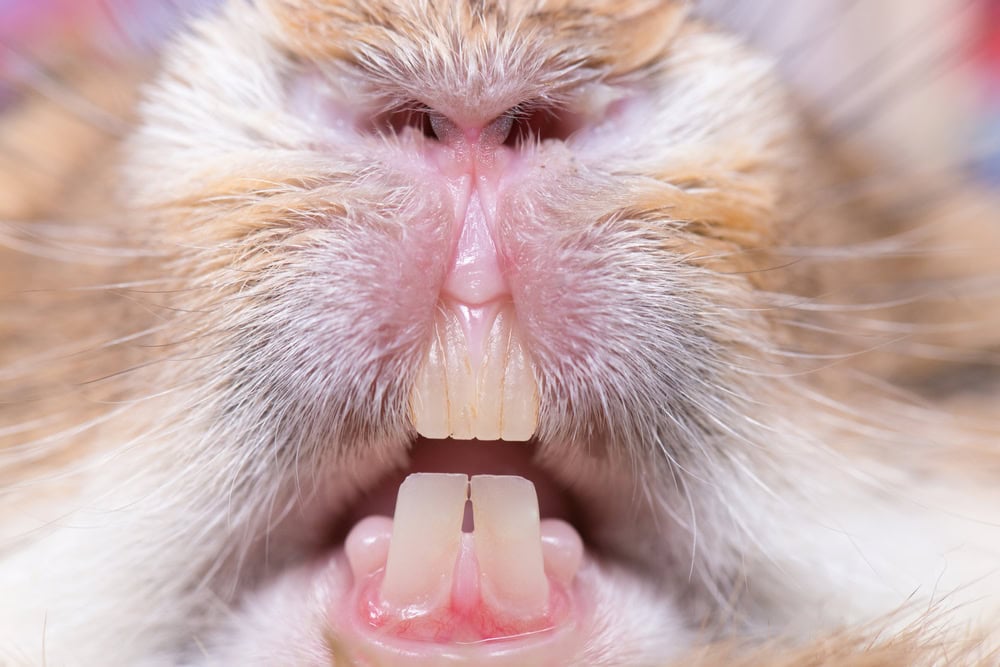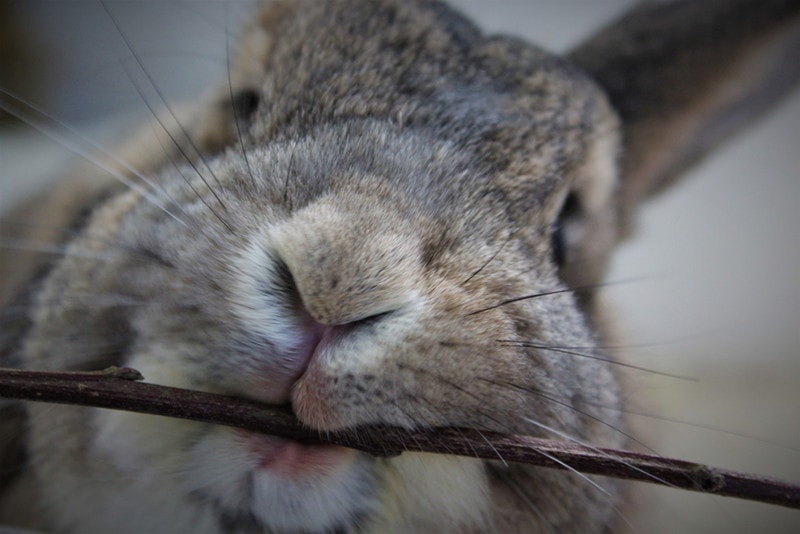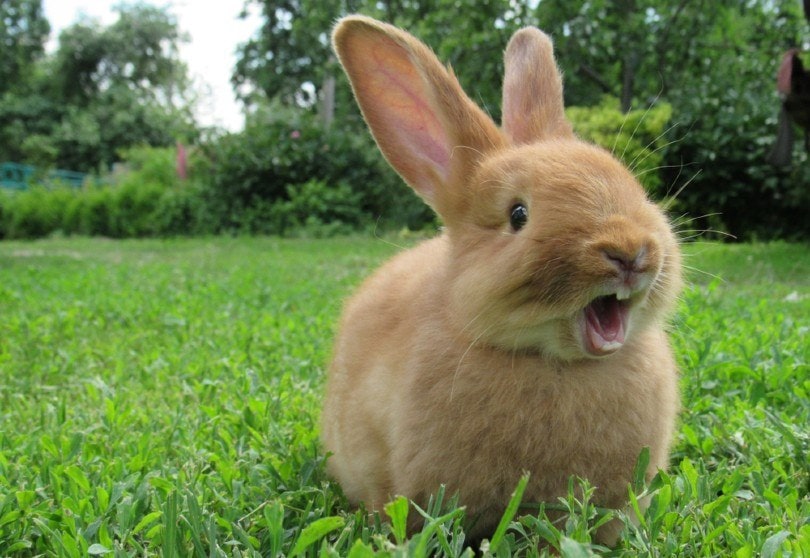- July 4, 2024
10 Surprising Vet-Verified Facts About Rabbit Teeth


The information is current and up-to-date in accordance with the latest veterinarian research.
Whether you own a pet rabbit or you’re watching them in your garden, one of the most fascinating parts of a rabbit is their teeth. At first blush, they don’t look all that different from ours, and in many ways, they may appear the same.
But while rabbit teeth are similar to ours in many ways, in others, they’re completely different. The more you learn, the more interesting they become. With that in mind, we’ve highlighted 10 of the most surprising and interesting facts about rabbit teeth for you here.

The 10 Facts About Rabbit Teeth
1. They Never Stop Growing
The reason you need to provide so much grass and hay for your rabbit isn’t only because they need all that food. It’s also because otherwise, their teeth will overgrow! They need grass and hay constantly to help them safely and efficiently digest food, using most of the otherwise indigestible fiber, but keeping their teeth in check is a big part of it.

2. Rabbits Have 28 Teeth
While cartoons really only highlight a rabbit’s front teeth, they have a mouthful of chompers! They have incisors, premolars, and molars to help them tear food apart and chew it up. Their front teeth are fairly sharp and help them chew through and bite off pieces of food, but once it’s torn up, the teeth in their cheek area grind it up into something smaller for them to safely swallow.
3. Rabbits Need Fiber to Wear Down Their Teeth
Rabbits need food with tons of fiber. Not only is all this fiber necessary for their digestive health, but it’s also a key component in what wears down their teeth. The fibrous portion of their diet does a great job of grinding away at them, which your rabbit needs so their teeth don’t overgrow.
4. Rabbit Teeth Can Break
Rabbit teeth are far from indestructible, and all it takes is for them to chew on some hard food the wrong way or get into a fight with another rabbit for one of their teeth to break. Already damaged or unhealthy teeth are more easily broken.
Dental fractures in rabbits can be incidental or very serious, and if they involve the pulp, the tooth may become infected and die. Either way, they will need to be checked by a veterinary dentist, as some teeth may be removed or need adequate treatment.

5. Rabbits Teeth Grow Curved
While you might think an overgrown rabbit tooth would grow straight down, that’s not the case. Rabbit’s teeth are cylindrical and have a natural curve. If a rabbit’s tooth starts to get too long, due to malocclusion or inability to meet the opposite tooth straight on, it starts to curve even more, which creates all kinds of problems for them. It’s kind of how human nails will curve after being too long—they don’t just keep growing straight out! This can cause sharp spurs, the tongue can become trapped, and the rabbit will be in pain and may struggle to eat.
6. Rabbits Use Their Teeth Just Like Us
While rabbits have different dietary needs and unique teeth, the way they use those teeth is pretty straightforward. Their incisors in the front of their mouth tear away at the food to make it easier to fit into their mouth, and from there, the premolars and molars in the side of their mouth grind the food up into smaller bits.
That’s the same way our teeth work. So really, a rabbit’s mouth isn’t all that different from ours. Or is it?
7. Rabbit’s Upper Incisors Only Have Enamel on One Side
One thing that’s extremely unique, interesting, and important with a rabbit’s upper incisors is that they only have enamel on one side of them. Enamel is hard and helps protect your teeth, but a rabbit needs to ensure their front teeth always stay sharp and grind down a bit so they don’t overgrow.
That’s why their incisors only have enamel on the outside. This protects the teeth from external factors, but it allows them to constantly stay sharp and wear down when they’re chewing.

8. You Don’t Need to Brush Rabbit Teeth
One advantage of grinding their teeth down little by little each day is that there’s no good reason to brush them. And most would not really allow it, anyway. You brush your teeth so they don’t rot, but no particular part of the rabbit’s teeth will stay in their mouth for long enough for this to be a problem, as they are always growing.
So, the next time you see some pet toothpaste in the pet care aisle, leave it there—your rabbit doesn’t need it!
9. You Can’t Neglect Rabbit Dental Care
Just because you don’t need to brush their teeth doesn’t mean you can neglect their oral hygiene. You need to ensure their teeth stay sharp, healthy, and at the right length; otherwise, your rabbit is going to be in a world of trouble.
If you suspect that your rabbit is having some sort of dental issue, you need to take them to a vet right away so they can address it. Rabbits don’t want pain in their mouth any more than the rest of us, and they are particularly sensitive to it, and it’s up to you to ensure their mouth stays pain-free day after day. Otherwise, they may get digestive issues, as they are not able to eat their food comfortably. This can lead to another serious illness called gut stasis, which may be life-threatening if not treated promptly.
10. Rabbits Chew Super Fast
If you’ve ever paid attention to a rabbit eating, you’ve probably seen them chewing like crazy. That’s not a trick of the eye. A rabbit can make up to 120 jaw movements a minute, which means their mouth is going side to side and front to back in a circular kind of motion twice a second!
All that movement allows them to grind their food up into extremely small pieces and wear their teeth down, both of which are necessary for their long-term health.


Conclusion
While a rabbit’s teeth might look and function similarly to ours in many ways, their unique features help ensure they can have a happy and healthy life whether they’re in the wild or in your home. Now that you know a bit more about them, you can care for them a bit better if you have a pet rabbit and appreciate them a bit more if you’re always seeing them chomping on something in your garden!
Featured Image Credit: Roselynne, Shutterstock
Tags
What do you think?
Related Articles

New Puppy Checklist: Gear You’ll Need for Your New Dog
Getting a new puppy is really exciting, but before you welcome them home, it’s important to prepare your space for them. Since puppies need a

How Big Do Mini Poodles Get? Vet Reviewed Average Weight & Growth Chart – Dogster
The information is current and up-to-date in accordance with the latest veterinarian research. Learn more » When you buy a Miniature Poodle, you might not

Can Police Dogs Smell Nicotine? Vet Verified Facts & Info – Dogster
The information is current and up-to-date in accordance with the latest veterinarian research. Learn more » While cigarette sales have been declining steadily for decades,

How Old Is 5 in Dog Years? Vet-Approved Guide to Each Size of Dog – Dogster
The information is current and up-to-date in accordance with the latest veterinarian research. Learn more » A common method for calculating a dog’s age is

